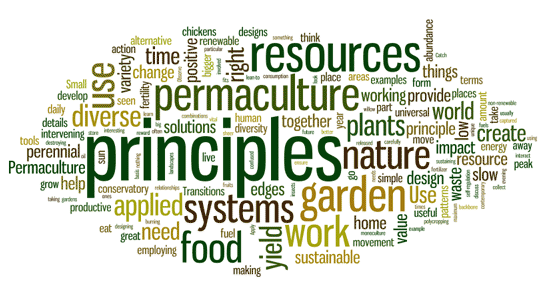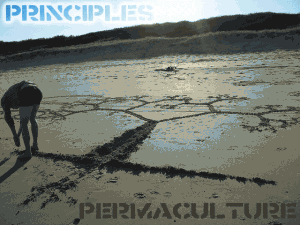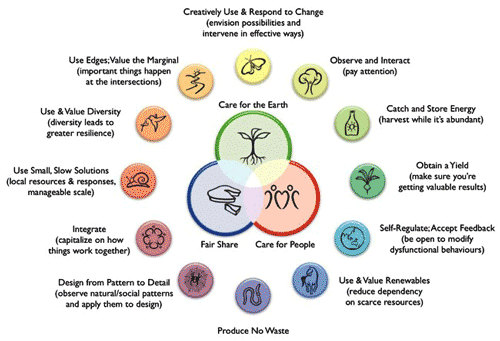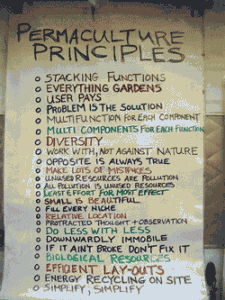Why does Permaculture have principles?
In permaculture there are 12 design principles, these principles are tools which allow us to creatively think about, plan, and carry out work which enables us to live in a low impact and ecologically sound way, these principles can applied to many areas of our daily lives. If permaculture itself is about designing human settlements along the same line as nature designs her landscapes, then the principles of permaculture are tools which will help us to achieve this.
The purpose of this piece about the principles of permaculture is to provide working examples of them in action and discuss their implications for the future.
Permaculture principles: definitions and applied examples
- Observe and interact: By taking time to engage with nature we can design solutions that suit our particular situation. This can work on a very simple level by considering which plants you are able to grow in relation to the amount of sunlight your garden receives due to its orientation
- Catch and store energy: By developing systems that collect resources at peak abundance, we can use them in times of need. By adding a lean-to or conservatory to your home, energy from the sun is captured and stored in the walls inside the conservatory and released in the evening when it is cooler outside
- Obtain a yield: Ensure that you are getting truly useful rewards as part of the work that you are doing. By growing your own resources you are obtaining a yield and a useful resource which is the reward for your work.
- Apply self-regulation and accept feedback: We need to discourage inappropriate activity to ensure that systems can continue to function well. If something is not working in your vegetable garden, look at the reasons why it isn’t working and provide and appropriate alternative which fits in with the holistic flow of your garden
- Use and value renewable resources and services: Make the best use of nature’s abundance to reduce our consumptive behaviour and dependence on non-renewable resources. Wood is a great renewable resource, I grow willow on my allotment plot for fuel for our wood burning stove at home, I use of the ashes from my burnt fuel to feed my fruit trees and soil. This allows me move away from using fossil fuels such as gas to heat our home.
- Produce no waste: By valuing and making use of all the resources that are available to us, nothing goes to waste. In a permaculture garden that keeps chickens, we can see this principle in operation, chicken poo makes a great fertilizer, and chickens also eat our kitchen waste and turn it into food in the form of eggs.
- Design from patterns to details: By stepping back, we can observe patterns in nature and society. These can form the backbone of our designs, with the details filled in as we go. We can learn how plants work together in nature to help us create resilient perennial food gardens which are self sustaining and low input in terms of the amount of labour involved, this is where there is synergy between people and nature.
- Integrate rather than segregate: By putting the right things in the right place, relationships develop between those things and they work together to support each other. Taller plants can protect smaller less sun tolerant plants with the shade that they provide
- Use small and slow solutions: Small and slow systems are easier to maintain than big ones, making better use of local resources and producing more sustainable outcomes. Small and slow solutions such as perennial food forests might take time to develop but this is cancelled out by the almost perpetual yield and fertility that increases from year to year, to the point where the permaculture food forest needs no human help other than to gather the fruits from it.
- Use and value diversity: Diversity reduces vulnerability to a variety of threats and takes advantage of the unique nature of the environment in which it resides. A very simple example of this principle in action can be seen in the practice of polycropping where diverse combinations of food are grown together, the benefits of this can be seen in the fact the predatory insects that would usually invade your garden and eat all of your plants is confused by the sheer variety of colours and scents in a diverse garden, and subsequently will move away from your garden to seek out food in a garden with more monoculture.
- Use edges and value the marginal: The interface between things is where the most interesting events take place. These are often the most valuable, diverse and productive elements in the system. In nature edges are diverse and productive areas, to create more fertile and diverse systems we need to build in bigger edges to our systems so that they spread their fertility and diversity.
- Creatively use and respond to change: We can have a positive impact on inevitable change by carefully observing, and then intervening at the right time. This principle can be applied directly to the Transitions movement, who have are trying to bring about sustainable low impact cultures as we reach a peak in oil production, responding to change in the manner to which the Transitions movement is currently doing is providing a positive alternative that is intervening at the right time in terms of our resource use.
Permaculture principles for a permanent culture
The principles of permaculture are universal and can be applied to a variety of climates, and situations, these principles really need to become part of how think and act on a daily basis if we are to create the fair and sustainable world that it is necessary to create. By employing these principles we employing positive restraints to our consumption and usage of resources, which is vital as we live in a world where resources are dwindling at a rapid rate. The permaculture principles are by no means fixed to the creation of perennial food systems, they can applied to the design of our homes, our places of work, our places of recreation.
Although these principles are practical universal measures, they go against the grain of a highly marketized world based on the bizarre assumption of infinite resources, everything in the contemporary world is geared to maximum yield with no other consideration other than creating a bigger yield, and it is this blinkered approach that is extracting, depleting and destroying our eco systems.
Useful links and Information:
Permaculture principles a whole site dedicated to the principles
Great little film about permaculture principles in action by the earthactivistas
Film of David Holmgren introducing the design principles:




